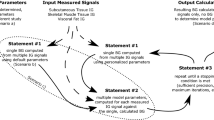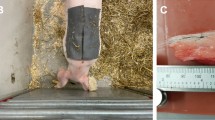Abstract
An approach for inference of blood glucose concentrations in real time is considered. First, a model that predicts the subcutaneous glucose concentration from the blood glucose concentration is presented. The model includes diffusive transport from the blood to the subcutaneous tissue and reactive-like cellular uptake of glucose. Next, the Phillips-Tikhonov regularization method is considered to solve the real-time input estimation problem that determines the blood glucose concentration given the subcutaneous glucose concentration. The inverse problem is regularized by imposing a smoothing condition to obtain a stable solution. Three different penalization functionals were considered in evaluating the regularization method using a synthetic function that approximates the subcutaneous glucose response to an oral glucose tolerance test in a human subject. Various levels of either white noise or time-correlated noise were superimposed onto the synthetic response to evaluate the sensitivity of the inverse to measurement error. For inversion assuming only diffusive transport, the optimal time interval of integration of previous subcutaneous measurements was found to be about 1.5/\(\hat \alpha \), where \(\hat \alpha \) -1 is the dominant time constant for the exchange of glucose between the blood and subcutaneous tissue. The optimal sampling rate was found to be 54\(\hat \alpha \). Linear regularizations based on minimization of first or second derivatives of the blood glucose concentration were found to be satisfactory, each yielding a minimum error that was about 50% greater than the measurement error. Including nonlinear, reactive-like uptake of glucose was found to decrease the error magnification factor slightly. Both the model and the inverse method relating blood and subcutaneous glucose concentrations are successfully applied to experimental measurements using glucose biosensors reported by Schmidtke et al. (Proc. Natl. Acad. Sci. USA 95:294–299, 1998). © 1999 Biomedical Engineering Society.
PAC99: 8780-y, 8717Aa
Similar content being viewed by others
REFERENCES
Armour, J., J. Lucisano, B. McKean, and D. Gough. Application of chronic intravascular blood glucose sensor in dogs. Diabetes 39:1519–1526, 1990.
Beck, J. V., B. Blackwell, and C. R. St. Clair. Inverse Heat Conduction. New York: Wiley, 1985, p. 308.
Bolinder, J., U. Ungerstedt, and P. Arner. Microdialysis measurement of the absolute glucose concentration in subcutaneous adipose tissue allowing glucose monitoring in diabetic patients. Diabetologia 35:1177–1180, 1992.
Carruthers, A. Facilitated diffusion of glucose. Physiol. Rev. 70:1135–1176, 1990.
Csöregi, E., D. W. Schmidke, and A. Heller. Design and optimization of a selective subcutaneously implantable glucose electrode based on ''wired'' glucose oxidase. Anal. Chem. 67:1240–1244, 1995.
De Nicolao, G., G. Sparacino, and C. Cobelli. Nonparametric Input Estimation in Physiological Systems: Problems, Methods, and Case Studies. Automatica 33:851–870, 1997.
Fischer, U., R. Ertle, P. Abel, K. Rebrin, E. Brunstein, H. Hahn von Dorsche, and E. J. Freyse. Assessment of subcutaneous glucose concentration: Validation of the Wick technique as a reference for implanted electrochemical sensors in mornal and diabetic dogs. Diabetologia 30:940–945, 1987.
Fraser, D. M. An introduction to in vivo biosensing: Progress and problems. In: Biosensors in the Body: Continuous In Vivo Monitoring, edited by D. Fraser. Chichester: Wiley, 1997, pp. 1–56.
Graham, N. Y. Smoothing with periodic cubic splines. Bell Syst. Tech. J. 62:101–110, 1983.
Hunt, B. R. Biased estimation for nonparametric identification of linear systems. Math. Biosci. 10:215–237, 1971.
Jansson, P. A., J. Fowelin, U. Smith, and P. Lönnroth. Characterization by microdialysis of intercellular glucose level in subcutaneous tissue in humans. Am. J. Physiol. 255:E218-E220, 1988.
Kaufman, P. J. The New Commodity Trading Systems and Methods. New York: Wiley, 1978, pp. 58–64.
Meyerhoff, C., F. Biscof, F. Sternberg, H. Zier, and E. F. Pfeiffer. On line continuous monitoring of subcutaneous tissue glucose in men by combining portable glucosensor with microdialysis. Diabetologia 35:1087–1092, 1992.
Pfeiffer, E. F., C. Meyerhoff, F. Biscof, F. S. Keck, and W. Kerner. On line continuous monitoring of subcutaneous tissue glucose is feasible by combining portable glucose sensor with microdialysis. Horm. Metab. Res. 25:121–124, 1993.
Pickup, J. C., G. S. Shaw, and D. J. Claremont. In vivo molecular sensing in diabetes mellitus: An implantable glucose sensor with direct electron transfer. Diabetologia 32:213–217, 1989.
Press, W. H., S. A. Teukolsky, W. T. Vetterling, and B. P. Flannery. Numerical Recipes in Fortran, 2nd ed. Cambridge: Cambridge University Press, 1992, p. 963.
Quinn, C. P., M. V. Pishko, D. W. Schmidtke, M. Ishikawa, J. G. Wagner, P. Raskin, J. A. Hubbell, and A. Heller. Kinetics of glucose delivery to subcutaneous tissue in rats measured with 0.3-mm amperometric microsensors. Am. J. Physiol. 269:E155-E161, 1995.
Reach, G. and G. S. Wilson. Can continuous glucose monitoring be used for the treatment of diabetes? Anal. Chem. 64:381A-386A, 1992.
Reinsch, C. H. J. Smoothing by spline function. Numer. Math. 10:177–183, 1967.
Schmidt, F. J., W. J. Sluiter, and A. J. M. Schoonen. Glucose concentration in subcutaneous extracellular space. Diabetes Care 16:695–700, 1993.
Schmidtke, D. W., A. C. Freeland, A. Heller, and R. T. Bonnecaze. Measurement and modeling of the transient difference between blood and subcutaneous glucose concentrations in the rat following injection of insulin. Proc. Natl. Acad. Sci. USA 95:294–299, 1998.
Schwilden, H., J. Honerkamp, and C. Elster. Pharmacokinetic model identification and parameter estimation as an ill-posed problem. Eur. J. Clin. Pharmacol. 45:545–550, 1993.
Sparacino, G. and C. Cobelli. A stochastic deconvolution method to reconstruct insulin secretion rate after a glucose stimulus. IEEE Trans. Biomed. Eng. 43:512–529, 1996.
Sternberg, F., C. Meyerhoff, F. J. Mennel, F. Biscof, H. Mayer, and E. F. Pfeiffer. Letter to the Editor: Comments on subcutaneous glucose monitoring. Diabetologia 37:540–541, 1994.
The Diabetes Control and Complication Trial Research Group. New Eng. J. Med. 329:977–986, 1993.
Thome-Duret, V., G. Reach, M. N. Gangnerau, F. Lemonnier, J. C. Klein, Y. Zhang, Y. Hu, and G. S. Wilson. Use of a subcutaneous glucose sensor to detect decreases in glucose concentration prior to observation in blood. Anal. Chem. 68:3822–3826, 1996.
Tikhonov, A. N., and V. Y. Arsenin. Solutions of Ill-Posed Problems. Washington, DC: Winston 1977.
Twomey, S. The application of numerical filtering to the solution of integral equations encountered in indirect sensing measurements. J. Franklin Inst. 279:95–109, 1965.
Velho, G., P. Froguel, and G. Reach. Determination of peritoneal glucose kinetics in rats: Implications for the peritoneal implantation of closed-loop insulin delivery systems. Diabetologia 32:331–336, 1989.
Yeh, J.-I., K. J. Verhey, and M. J. Birnbaum. Kinetic analysis of glucose transporter trafficking in fibroblasts and adipocytes. Biochemistry 34:523–531, 1995.
Author information
Authors and Affiliations
Rights and permissions
About this article
Cite this article
Freeland, A.C., Bonnecaze, R.T. Inference of Blood Glucose Concentrations from Subcutaneous Glucose Concentrations: Applications to Glucose Biosensors. Annals of Biomedical Engineering 27, 525–537 (1999). https://doi.org/10.1114/1.196
Issue Date:
DOI: https://doi.org/10.1114/1.196




